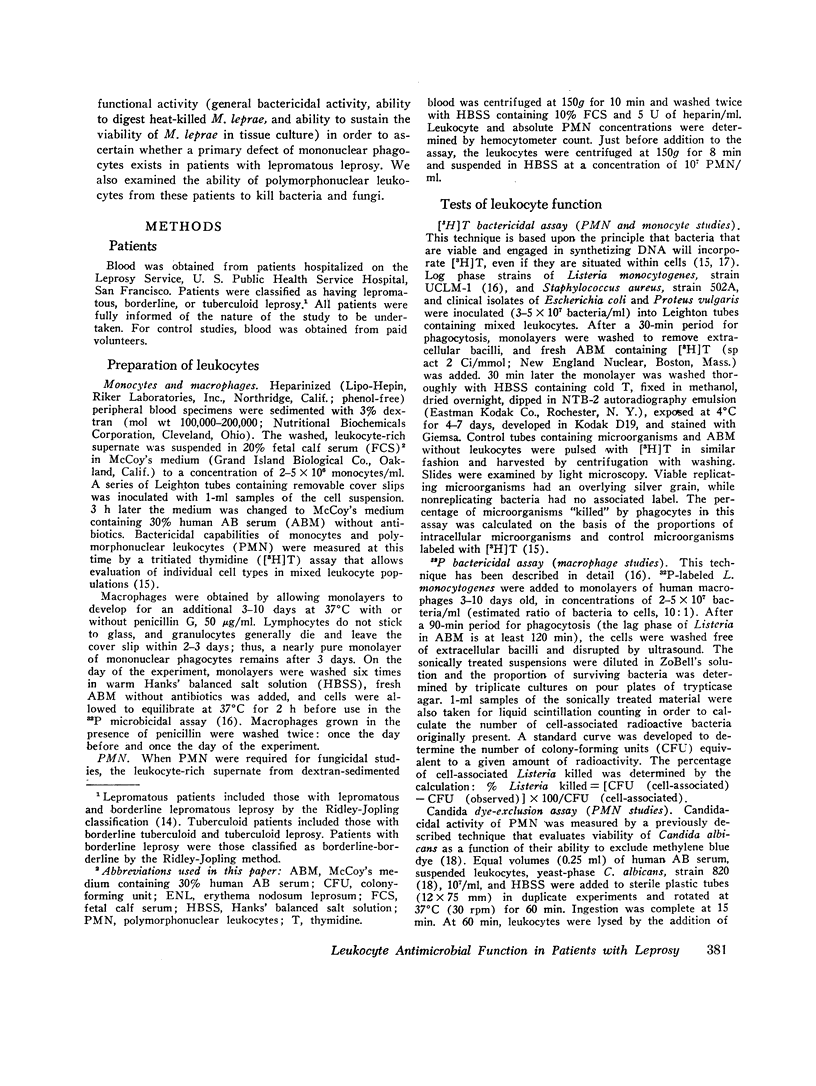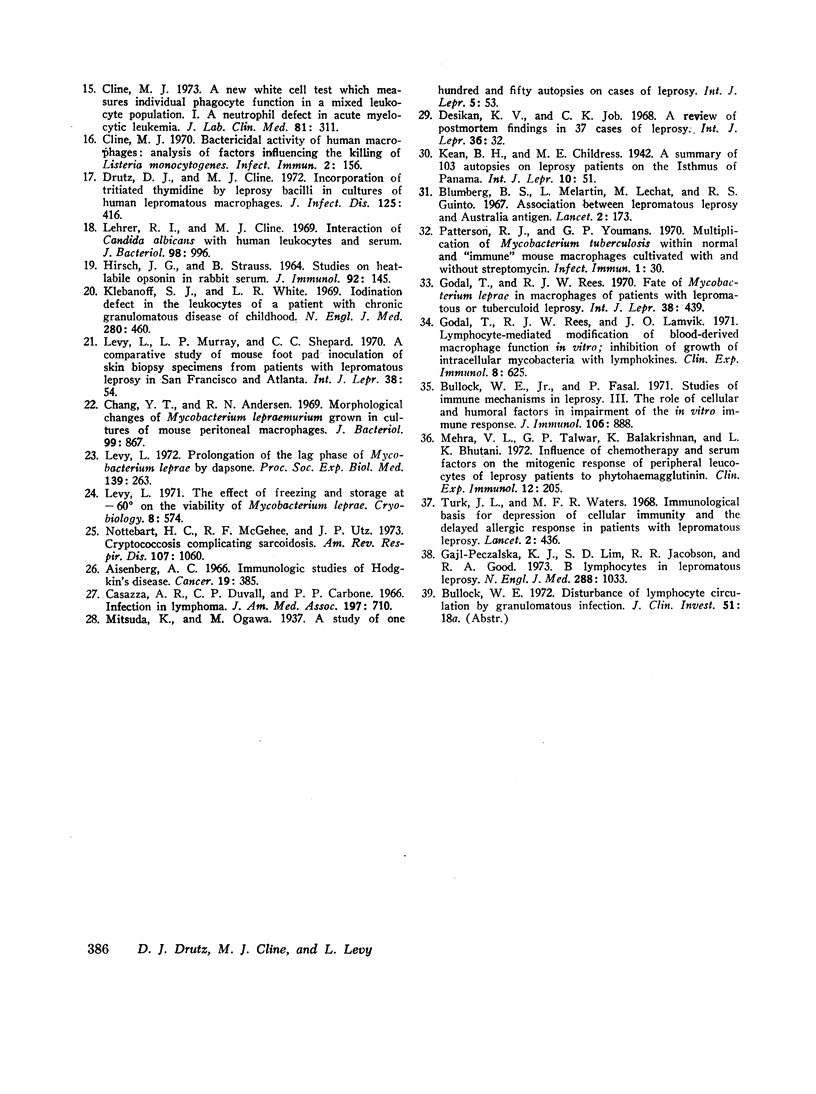Abstract
Patients with lepromatous leprosy are unresponsive to lepromin skin-test material and possess defective lymphocyte function in vitro, including impaired mitogenesis in response to antigens of Mycobacterium leprae. It has been claimed that their macrophages cannot digest M. leprae in vitro; such a defect could explain both lepromin nonreactivity and impaired lymphocyte function on the basis of failure of the afferent limb of the immune response (i.e., defective macrophage "processing" of M. leprae). The present studies indicate that macrophages from patients with lepromatous and tuberculoid leprosy and from normal donors do not differ in their ability to digest heat-killed M. leprae in vitro, or in their ability to sustain the viability of M. leprae in tissue culture; that monocytes, macrophages, and polymorphonuclear leukocytes of leprosy patients and controls possess equivalent microbicidal activity against Listeria monocytogenes, Escherichia coli, Proteus vulgaris, Staphylococcus aureus, and Candida albicans; and that polymorphonuclear leukocytes from patients with lepromatous leprosy iodinate ingested bacteria normally. Whether the basic immune defect leading to the development of lepromatous leprosy resides in the lymphocyte or in the macrophage remains to be determined. However, the present study shows that phagocytic cells from patients with either principal form of leprosy function normally in a variety of sophisticated tests of antimicrobial function.
Full text
PDF






Selected References
These references are in PubMed. This may not be the complete list of references from this article.
- Barbieri T. A., Correa W. M. Human macrophage culture. The leprosy prognostic test (LPT). Int J Lepr Other Mycobact Dis. 1967 Jul-Sep;35(3):377–381. [PubMed] [Google Scholar]
- Beiguelman B. Leprosy and genetics. A review of past research with remarks concerning future investigations. Bull World Health Organ. 1967;37(3):461–476. [PMC free article] [PubMed] [Google Scholar]
- Blumberg B. S., Melartin L., Lechat M., Guinto R. S. Association between lepromatous leprosy and Australia antigen. Lancet. 1967 Jul 22;2(7508):173–176. doi: 10.1016/s0140-6736(67)90003-7. [DOI] [PubMed] [Google Scholar]
- Brown R. S., Haynes H. A., Foley H. T., Godwin H. A., Berard C. W., Carbone P. P. Hodgkin's disease. Immunologic, clinical, and histologic features of 50 untreated patients. Ann Intern Med. 1967 Aug;67(2):291–302. doi: 10.7326/0003-4819-67-2-291. [DOI] [PubMed] [Google Scholar]
- Bullock W. E., Jr, Fasal P. Studies of immune mechanisms in leprosy. 3. The role of cellular and humoral factors in impairment of the in vitro immune response. J Immunol. 1971 Apr;106(4):888–899. [PubMed] [Google Scholar]
- Casazza A. R., Duvall C. P., Carbone P. P. Infection in lymphoma. Histology, treatment, and duration in relation to incidence and survival. JAMA. 1966 Aug 29;197(9):710–716. doi: 10.1001/jama.197.9.710. [DOI] [PubMed] [Google Scholar]
- Chang Y. T., Andersen R. N. Morphological changes of Mycobacterium lepraemurium grown in cultures of mouse peritoneal macrophages. J Bacteriol. 1969 Sep;99(3):867–875. doi: 10.1128/jb.99.3.867-875.1969. [DOI] [PMC free article] [PubMed] [Google Scholar]
- Cline M. J. A new white cell test which measures individual phagocyte function in a mixed leukocyte population. I. A neutrophil defect in acute myelocytic leukemia. J Lab Clin Med. 1973 Feb;81(2):311–316. [PubMed] [Google Scholar]
- Cline M. J. Bactericidal Activity of Human Macrophages: Analysis of Factors Influencing the Killing of Listeria monocytogenes. Infect Immun. 1970 Aug;2(2):156–161. doi: 10.1128/iai.2.2.156-161.1970. [DOI] [PMC free article] [PubMed] [Google Scholar]
- Desikan K. V., Job C. K. A review of postmortem findings in 37 cases of leprosy. Int J Lepr Other Mycobact Dis. 1968 Jan-Mar;36(1):32–44. [PubMed] [Google Scholar]
- Drutz D. J., Cline M. J. Incorporation of tritiated thymidine by leprosy bacilli in cultures of human lepromatous macrophages. J Infect Dis. 1972 Apr;125(4):416–419. doi: 10.1093/infdis/125.4.416. [DOI] [PubMed] [Google Scholar]
- Dwyer J. M., Bullock W. E., Fields J. P. Disturbance of the blood T:B lymphocyte ratio in lepromatous leprosy. Clinical and immunologic correlations. N Engl J Med. 1973 May 17;288(20):1036–1039. doi: 10.1056/NEJM197305172882002. [DOI] [PubMed] [Google Scholar]
- Gajl-Peczalska K. J., Lim S. D., Jacobson R. R., Good R. A. B lymphocytes in lepromatous leprosy. N Engl J Med. 1973 May 17;288(20):1033–1035. doi: 10.1056/NEJM197305172882001. [DOI] [PubMed] [Google Scholar]
- Godal T., Rees R. J. Fate of Mycobacterium leprae in macrophages of patients with lepromatous or tuberculoid leprosy. Int J Lepr Other Mycobact Dis. 1970 Oct-Dec;38(4):439–442. [PubMed] [Google Scholar]
- Godal T., Rees R. J., Lamvik J. O. Lymphocyte-mediated modification of blood-derived macrophage function in vitro; inhibition of growth of intracellular mycobacteria with lymphokines. Clin Exp Immunol. 1971 Apr;8(4):625–637. [PMC free article] [PubMed] [Google Scholar]
- HIRSCH J. G., STRAUSS B. STUDIES ON HEAT-LABILE OPSONIN IN RABBIT SERUM. J Immunol. 1964 Jan;92:145–154. [PubMed] [Google Scholar]
- James D. G. Immunology of sarcoidosis. Lancet. 1966 Sep 17;2(7464):633–635. doi: 10.1016/s0140-6736(66)91944-1. [DOI] [PubMed] [Google Scholar]
- Klebanoff S. J., White L. R. Iodination defect in the leukocytes of a patient with chronic granulomatous disease of childhood. N Engl J Med. 1969 Feb 27;280(9):460–466. doi: 10.1056/NEJM196902272800902. [DOI] [PubMed] [Google Scholar]
- Lehrer R. I., Cline M. J. Interaction of Candida albicans with human leukocytes and serum. J Bacteriol. 1969 Jun;98(3):996–1004. doi: 10.1128/jb.98.3.996-1004.1969. [DOI] [PMC free article] [PubMed] [Google Scholar]
- Levy L., Murray L. P., Shepard C. C. A comparative study of mouse foot pad inoculation of skin biopsy specimens from patients with lepromatous leprosy in San Francisco and Atlanta. Int J Lepr Other Mycobact Dis. 1970 Jan-Mar;38(1):54–59. [PubMed] [Google Scholar]
- Levy L. Prolongation of the lag phase of Mycobacterium leprae by dapsone. Proc Soc Exp Biol Med. 1972 Jan;139(1):263–266. doi: 10.3181/00379727-139-36123. [DOI] [PubMed] [Google Scholar]
- Mackaness G. B. Resistance to intracellular infection. J Infect Dis. 1971 Apr;123(4):439–445. doi: 10.1093/infdis/123.4.439. [DOI] [PubMed] [Google Scholar]
- Mehra V. L., Talwar G. P., Balakrishnan K., Bhutani L. K. Influence of chemotherapy and serum factors on the mitogenic response of peripheral leucocytes of leprosy patients to phytohaemagglutinin. Clin Exp Immunol. 1972 Oct;12(2):205–213. [PMC free article] [PubMed] [Google Scholar]
- Nottebart H. C., McGehee R. F., Utz J. P. Cryptococcosis complicating sarcoidosis. Am Rev Respir Dis. 1973 Jun;107(6):1060–1063. doi: 10.1164/arrd.1973.107.6.1060. [DOI] [PubMed] [Google Scholar]
- Patterson R. J., Youmans G. P. Demonstration in tissue culture of lymphocyte-mediated immunity to tuberculosis. Infect Immun. 1970 Jun;1(6):600–603. doi: 10.1128/iai.1.6.600-603.1970. [DOI] [PMC free article] [PubMed] [Google Scholar]
- Patterson R. J., Youmans G. P. Multiplication of Mycobacterium tuberculosis Within Normal and "Immune" Mouse Macrophages Cultivated With and Without Streptomycin. Infect Immun. 1970 Jan;1(1):30–40. doi: 10.1128/iai.1.1.30-40.1970. [DOI] [PMC free article] [PubMed] [Google Scholar]
- Ridley D. S., Jopling W. H. Classification of leprosy according to immunity. A five-group system. Int J Lepr Other Mycobact Dis. 1966 Jul-Sep;34(3):255–273. [PubMed] [Google Scholar]
- Seeger R. C., Oppenheim J. J. Synergistic interaction of macrophages and lymphocytes in antigen-induced transformation of lymphocytes. J Exp Med. 1970 Jul 1;132(1):44–65. doi: 10.1084/jem.132.1.44. [DOI] [PMC free article] [PubMed] [Google Scholar]
- Simon H. B., Sheagren J. N. Enhancement of macrophage bactericidal capacity by antigenically stimulated immune lymphocytes. Cell Immunol. 1972 Jun;4(2):163–174. doi: 10.1016/0008-8749(72)90015-9. [DOI] [PubMed] [Google Scholar]
- Talwar G. P., Krishnan A. D., Mehra V. L., Blum E. A., Pearson J. M. Evaluation of cell mediated immune responses in untreated cases of leprosy. Clin Exp Immunol. 1972 Oct;12(2):195–203. [PMC free article] [PubMed] [Google Scholar]
- Turk J. L., Bryceson A. D. Immunological phenomena in leprosy and related diseases. Adv Immunol. 1971;13:209–266. doi: 10.1016/s0065-2776(08)60185-6. [DOI] [PubMed] [Google Scholar]
- Turk J. L., Waters M. F. Immunological basis for depression of cellular immunity and the delayed allergic response in patients with lepromatous leprosy. Lancet. 1968 Aug 24;2(7565):436–438. doi: 10.1016/s0140-6736(68)90472-8. [DOI] [PubMed] [Google Scholar]
- Unanue E. R., Cerottini J. C. The immunogenicity of antigen bound to the plasma membrane of macrophages. J Exp Med. 1970 Apr 1;131(4):711–725. doi: 10.1084/jem.131.4.711. [DOI] [PMC free article] [PubMed] [Google Scholar]


